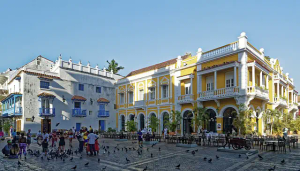Navigating the Rich Landscapes of Guinea: A Guide to Getting Around

Guinea, located on the western coast of Africa, is a land of diverse landscapes, cultural heritage, and warm hospitality. From the vibrant markets of Conakry to the misty Fouta Djallon highlands and the untamed wilderness of the National Parks, Guinea offers a mesmerizing experience for travelers. However, getting around the country can be challenging due to its vast terrains and limited infrastructure. In this article, we will explore the various transportation options available for travelers seeking to navigate the treasures of Guinea.
Air Travel
Guinea is well-connected by air, and the primary gateway is the Conakry International Airport. Several international airlines offer flights to and from Conakry, connecting the country to major cities in Africa, Europe, and beyond. For internal flights, there are a few domestic airlines that operate routes between Conakry and other major cities like Labé, Kankan, and Nzérékoré. Though air travel is more expensive, it can save significant time and effort for those exploring distant regions.
Road Networks
The road infrastructure in Guinea is a mix of paved and unpaved roads, which can vary in quality. Major highways connect the capital, Conakry, to several regional centers. However, roads in remote areas may be rough and poorly maintained, making travel challenging during the rainy season. Travelers should exercise caution, especially during the rainy season, when roads may become impassable or prone to flooding.
Public Transport
Public transport in Guinea mainly consists of minibusses known as “bush taxis” or “sept-places.” These minibusses follow specific routes and can be found in major cities and towns. They are the most common and affordable means of getting around, but be prepared for crowded conditions and frequent stops. If you prefer more comfort, you can also hire private taxis, but this option is more expensive.
Rail Transport
Guinea’s railway system is limited, and the only operational line runs between Conakry and Kankan. Although it may not be the fastest option, traveling by train offers a unique experience, passing through picturesque landscapes and providing an opportunity to interact with locals during the journey.
Waterways
With numerous rivers crisscrossing the country, water transport is a vital means of travel in Guinea. Ferries and boats operate on rivers such as the Niger and the Milo, connecting various cities and regions. If you plan to explore the coastal regions, boats and canoes are available for transport between islands and fishing villages.
Motorcycle Taxis
In urban areas and smaller towns, motorcycle taxis, known as “moto-taxis,” are a popular mode of transport. They are a quick and convenient way to navigate through crowded streets and reach destinations that might not be accessible by larger vehicles.
Precautions and Considerations
While exploring Guinea, it’s essential to be aware of potential safety concerns. Check the latest travel advisories and be cautious about traveling after dark in some areas. Make sure to carry sufficient cash, as ATMs may be scarce outside major cities. It’s also wise to learn a few phrases in French or local languages, as English is not widely spoken.
Conclusion
Guinea offers a wealth of natural and cultural treasures waiting to be discovered by intrepid travelers. While getting around the country can be challenging, it is undoubtedly a rewarding experience. Whether you choose to soar above the landscapes by air, journey through the heart of the country by road, or navigate the rivers on boats, Guinea promises an unforgettable adventure that will leave you with cherished memories for a lifetime.







